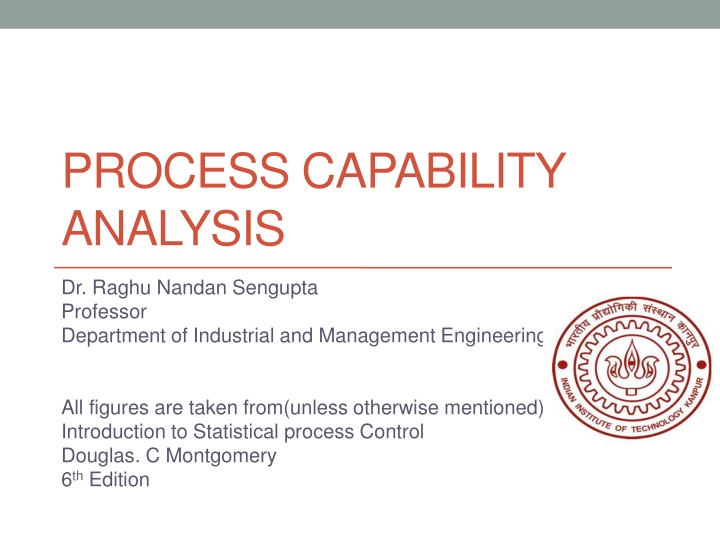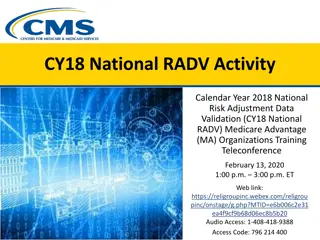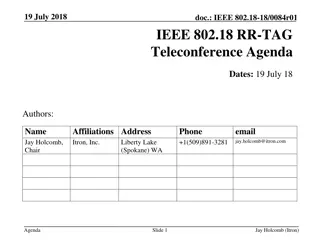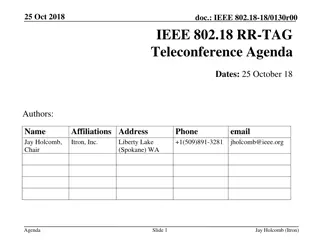EPSO Conference 2020: Opening Teleconference and Programme Highlights
The 29th EPSO Conference in The Hague took place online on September 23rd and 24th, 2020, featuring a unique teleconference opening and diverse sessions on topics such as regulatory compliance, national responses to COVID-19, future regulations, and innovative inspection methods. Join experts from the European Partnership for Supervisory Organisations in health and social care for insightful discussions and new perspectives.
Download Presentation

Please find below an Image/Link to download the presentation.
The content on the website is provided AS IS for your information and personal use only. It may not be sold, licensed, or shared on other websites without obtaining consent from the author.If you encounter any issues during the download, it is possible that the publisher has removed the file from their server.
You are allowed to download the files provided on this website for personal or commercial use, subject to the condition that they are used lawfully. All files are the property of their respective owners.
The content on the website is provided AS IS for your information and personal use only. It may not be sold, licensed, or shared on other websites without obtaining consent from the author.
E N D
Presentation Transcript
PROCESS CAPABILITY ANALYSIS Dr. Raghu Nandan Sengupta Professor Department of Industrial and Management Engineering All figures are taken from(unless otherwise mentioned): Introduction to Statistical process Control Douglas. C Montgomery 6thEdition
Introduction Statistical techniques can be helpful throughout the product cycle, including development activities prior to manufacturing, in quantifying process variability, in analyzing this variability relative to product requirements or specifications, and in assisting development and manufacturing in eliminating or greatly reducing this variability. This general activity is called process capability analysis Process capability refers to the uniformity of the process. There are two ways to think of this variability: 1. The natural or inherent variability in a critical-to-quality characteristic at a specified time; that is, instantaneous variability 2. The variability in a critical-to-quality characteristic over time We define process capability analysis as a formal study to estimate process capability
Major uses of Process capability Analysis 1. Predicting how well the process will hold the tolerances 2. Assisting product developers/designers in selecting or modifying a process 3. Assisting in establishing an interval between sampling for process monitoring 4. Specifying performance requirements for new equipment 5. Selecting between competing suppliers and other aspects of supply chain management 6. Planning the sequence of production processes when there is an interactive effect of processes on tolerances 7. Reducing the variability in a process
Probability Plotting 20 observations on glass container bursting strength: 197, 200, 215, 221, 231, 242, 245, 258, 265, 265, 271, 275, 277, 278, 280, 283, 290, 301, 318, and 346 Fig 8.4
Interpretation Mean of the normal distribution is the fiftieth percentile, which we may estimate from Fig. 8.4 as approximately 265 psi, and the standard deviation of the distribution is the slope of the straight line. It is convenient to estimate the standard deviation as the difference between the eighty-fourth and the fiftieth percentiles. For the strength data shown above and using Fig. 8.4, we find that Note that and are not far from the sample average and standard deviation s = 32.02. Care should be exercised in using probability plots. If the data do not come from the assumed distribution, inferences about process capability drawn from the plot may be seriously in error
Process Capability Ratios Recall (8.4)
Process Capability Ratios Equations (8.4) and (8.5) assume that the process has both upper and lower specification limits. For one-sided specifications, one-sided process-capability ratios are used. One sided PCRs are defined as follows:
Values of Process Capability Ratio Several values of the PCR Cp along with the associated values of process fallout, expressed in defective parts or nonconforming units of product per million (ppm)
Assumptions 1. The quality characteristic has a normal distribution. 2. The process is in statistical control. 3. In the case of two-sided specifications, the process mean is centered between the lower and upper specification limits. These assumptions are absolutely critical to the accuracy and validity of the reported numbers, and if they are not valid, then the reported quantities may be seriously in error. Stability or statistical control of the process is also essential to the correct interpretation of any PCR What we actually observe in practice is an estimate of the PCR. This estimate is subject to error in estimation, since it depends on sample statistics
Process Capability Analysis using control chart Histograms, probability plots, and process capability ratios summarize the performance of the process. They do not necessarily display the potential capability of the process because they do not address the issue of statistical control The control chart should be regarded as the primary technique of process capability analysis. The x and R charts should be used whenever possible, because of the greater power and better information they provide relative to attributes charts. However, both p charts and c (or u) charts are useful in analyzing process capability.
Conclusions This example illustrates a process that is in control but operating at an unacceptable level. There is no evidence to indicate that the production of nonconforming units is operator-controllable. Engineering and/or management intervention will be required either to improve the process or to change the requirements if the quality problems with the bottles are to be solved. The objective of these interventions is to increase the process capability ratio to at least a minimum acceptable level. The control chart can be used as a monitoring device or logbook to show the effect of changes in the process on process performance. Sometimes the process capability analysis indicates an out-of-control process. It is unsafe to estimate process capability in such cases. The process must be stable in order to produce a reliable estimate of process capability.
Process Capability Using Designed Experiments A designed experiment is a systematic approach to varying the input controllable variables in the process and analyzing the effects of these process variables on the output. Designed experiments are also useful in discovering which set of process variables is influential on the output, and at what levels these variables should be held to optimize process performance. One of the major uses of designed experiments is in isolating and estimating the sources of variability in a process. For example, consider a machine that fills bottles with a soft-drink beverage. Each machine has a large number of filling heads that must be independently adjusted. The quality characteristic measured is the syrup content (in degrees brix) of the finished product. There can be variation in the observed brix ( 2B) because of machine variability ( 2M), head variability ( 2H), and analytical test variability ( 2A). The variability in the observed brix value is
Explanation An experiment can be designed, involving sampling from several machines and several heads on each machine, and making several analyses on each bottle, which would allow estimation of the variances. Suppose that the results appear as in Fig. 8.13. Since a substantial portion of the total variability in observed brix is due to variability between heads, this indicates that the process can perhaps best be improved by reducing the head-to- head variability. This could be done by more careful setup or by more careful control of the operation of the machine.
Process Capability Analysis Using Attribute Data When dealing with nonconformities or defects, a defects per unit (DPU) statistic is often used as a measure of capability, where Here the unit is something that is delivered to a customer and can be evaluated or judged as to its suitability. Some examples include: 1. An invoice 2. A shipment 3. A customer order 4. An enquiry or call. The defects or nonconformities are anything that does not meet the customer requirements, such as: 1. An error on an invoice 2. An incorrect or incomplete shipment 3. An incorrect or incomplete customer order 4. A call that is not satisfactorily completed
DPMO The DPU measure does not directly take the complexity of the unit into account. A widely used way to do this is the defect per million opportunities (DPMO) measure Opportunities are the number of potential chances within a unit for a defect to occur. For example, on a purchase order, the number of opportunities would be the number of fields in which information is recorded times two, because each field can either be filled out incorrectly or blank (information is missing). It is important to be consistent about how opportunities are defined, as a process may be artificially improved simply by increasing the number of opportunities over time.
Gauge Capability Generally, in any activity involving measurements, some of the observed variability will be inherent in the units or items that are being measured, and some of the variability will result from the measurement system that is used. The measurement system will consist (minimally) of an instrument or gauge, and it often has other components, such as the operator(s) that uses it and the conditions or different points in time under which the instrument is used. There may also be other factors that impact measurement system performance, such as setup or calibration activities. The purpose of most measurement systems capability studies is to: 1. Determine how much of the total observed variability is due to the gauge or instrument 2. Isolate the components of variability in the measurement system 3 3. Assess whether the instrument or gauge is capable (that is, is it suitable for the intended application)
R & R In this section we will introduce the two R s of measurement systems capability: Repeatability (do we get the same observed value if we measure the same unit several times under identical conditions), and Reproducibility (how much difference in observed values do we experience when units are measured under different conditions, such as different operators, time periods, and so forth). Other important aspects of measurement systems capability The linearity of a measurement system reflects the differences in observed accuracy and/or precision experienced over the range of measurements made by the system. Stability, or different levels of variability in different operating regimes, can result from warm-up effects, environmental factors, inconsistent operator performance, and inadequate standard operating procedure. Bias reflects the difference between observed measurements and a true value obtained from a master or gold standard, or from a different measurement technique known to produce accurate values.
Precision to Tolerance Ratio Precision to Tolerance Ratio Values of the estimated ratio P/T of 0.1 or less often are taken to imply adequate gauge capability.























